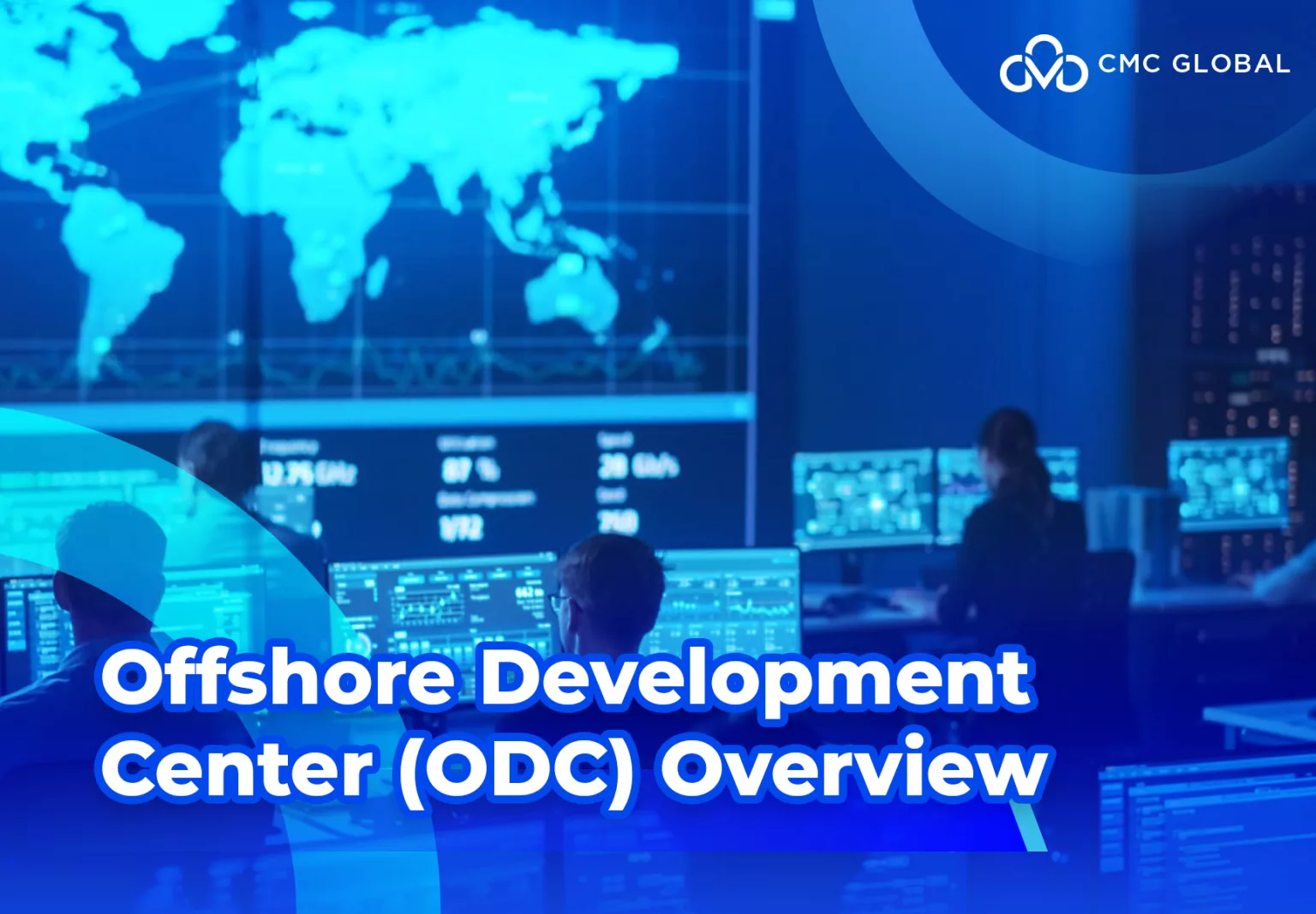With the global surge in demand for software development, offshore software development centers have been emerging and gaining prominence in recent years.
For those in the IT sector, the concept of an “offshore software development center” is not something new.
These centers are increasingly favored by numerous companies because of the advantages they offer.
So, What is an Offshore Development Center?

An offshore development center (ODC) or offshore delivery center is a facility located in a distant region, over three time zones away from your location, equipped with a dedicated development team, office space, administrative staff, and all necessary infrastructure.
ODC can also refer to nearshore development centers, where the team, office, and administrative staff are located within three time zones of your location. For this article’s purposes, ODC will signify offshore development centers.
The unique aspect of an offshore development center is its customization to meet your organization’s specific needs. The team can handle a wide range of tasks, including technical and business support, administrative duties, and comprehensive product development. An ODC functions as an extension of your in-house team but is based offshore.
You can establish an ODC independently or collaborate with a partner with an established presence in your preferred location. If you choose a partner, they will handle recruitment, accounting, office setup, legal matters, HR management, local IT support, security, and other administrative responsibilities.
5 Benefits Of ODC
Access to the Global Talent Pool
According to Deloitte, 50% of businesses find recruiting developers with the right skills to be a significant challenge. Offshoring addresses this issue by removing geographical barriers and expanding the available talent pool, making recruitment easier and quicker.
By looking for tech talent in offshore locations, you can also access experts in cutting-edge technologies like deep learning, computer vision, and extended reality.
Cost Savings
Cost pressure is a major concern for companies aiming to expand their software development capabilities. Accelerance reports that hiring an offshore development team can save you between 39% and 72% in costs, depending on the location, compared to hiring an onshore team in Seattle, Washington.

Several factors contribute to the cost-efficiency of setting up an ODC. Offshore locations often have a lower cost of living, leading to reduced labor costs. Infrastructure expenses, such as office rent, are also lower. Additionally, some jurisdictions offer tax incentives for the tech sector, further reducing overall costs.
Local Expertise
When planning to extend your business into a market or region where your offshore development center (ODC) is based, the team there can offer essential insights to help you navigate the area’s unique characteristics. For instance, you can assign your ODC to:
– Customize your product for the local market
– Perform market and user research
– Tailor product design to align with local trends
Simplified Recruitment and Management
Choosing to hire offshore developers independently to create a remote team comes with numerous challenges. You must dedicate time and funds to recruiting both developers and administrative personnel. Additionally, you need to establish the necessary infrastructure for the team to function effectively.
However, partnering with an offshore development service provider can alleviate much of this burden. They handle the thorough vetting of specialists’ skills (while still allowing you to make the final hiring decision, if desired), oversee daily operations, and ensure compliance with local laws. This way, you won’t need to allocate resources to understanding the local tax codes or addressing HR issues.
Ongoing Coverage
An offshore development center (ODC) can seamlessly take over operations once your in-house team finishes for the day, acting as an extension of your team. This setup ensures around-the-clock business continuity, accelerating the time-to-market for new features or products.
Continuous coverage is also advantageous for maintenance and support tasks assigned to your ODC team. The offshore team ensures these aspects are consistently managed. They can also detect and address security incidents or breaches swiftly, while maintaining essential functions.
ODC vs In-house team: What’s the difference?
How does establishing an offshore development center compare to hiring additional in-house staff? Here are three key distinctions between the two methods:
- Location: Although you could create a remote in-house team, a significant number of tech employees in the US still work partly (52%) or entirely (28%) in office settings. Consequently, your in-house team is likely to operate from one of your existing locations. By contrast, an offshore development center will typically be situated over three time zones away.
- Costs: Employing in-house staff involves numerous additional expenses, such as recruitment, benefits, payroll taxes, office space, and equipment (real employment costs generally range from 1.25 to 1.4 times the salary). While an ODC might incur some similar expenses (e.g., infrastructure), these are generally lower offshore. Moreover, payroll taxes and other costs are not your concern if you engage a partner to establish the ODC.
- Speed: When partnering with a local vendor to set up an offshore development center, they often have a ready pool of specialists who can quickly join the ODC. This enables you to assemble your team more swiftly compared to the in-house recruitment process.

8 Key Aspects Of Setting Up An ODC
If you consider the offshore development center (ODC) model suitable for your development needs, here are eight key factors to keep in mind when establishing one:
Define Your Needs and Goals
Begin by identifying the specific tasks the ODC will handle and your objectives for setting it up. Determine the level of control you want over the offshore team, the budget available, and the appropriate ODC model.
Assess Feasibility
Conduct a feasibility analysis before committing to an ODC. Evaluate opportunities, strengths, weaknesses, and threats, along with required versus available resources. Consider talent availability, legal and compliance restrictions, potential risks, and financial costs.
Choose the Ideal Location
When comparing locations for your ODC, consider the following factors:
– Expertise available in the country
– Security and compliance requirements
– Costs of labor, office space, and infrastructure
– Cultural differences
– Time zone differences
– Internet connectivity
– Exchange rate volatility
– Geopolitical stability
– English proficiency
Decide on a DIY or Vendor Approach
You can either set up an ODC yourself by registering a branch in the chosen location, handling all legal, accounting, recruitment, infrastructure setup, and management activities. Alternatively, you can partner with a company like Luxoft to manage these tasks for you.
Establish the Infrastructure
Ensure the infrastructure not only supports productivity but also enhances security. Beyond office space and equipment, consider:
– Setting up backup systems
– Securing the network
– Implementing permission-based access to sensitive data and the premises
Select the Team
If you choose to establish the ODC yourself, you’ll manage all recruitment processes, from job postings to screening, interviewing, and selecting candidates. This can be time-consuming and costly. Alternatively, your ODC partner can streamline this by providing access to its internal talent pool.
Onboard the Team
Once all roles are filled, ensure the team understands your in-house operations, values, standards, protocols, expectations, and management style. Clearly define communication and project management tools, roles and responsibilities, and knowledge management and transfer measures during onboarding.
Monitor Performance
To ensure your ODC team meets your needs, define key performance indicators (KPIs) in advance, communicate them to the offshore team, and track them to measure performance.

Asia as a Popular Destination for Your ODC
This region offers numerous advantages due to its rapid technological development. Many Asians possess a good command of English, and there is an abundance of developers and software engineers across the continent.
Asia is seen as a prime location for outsourcing and offshore development due to its skilled workforce and favorable time zones. Several countries in the region have already established themselves as mature outsourcing markets.
- India is a key player in the IT industry for offshore outsourcing and ODCs. As a pioneer since the 1980s, it currently boasts 3 million engineers.
- China, with its vast population, has a relatively young but rapidly growing IT outsourcing and offshore development market. Over the past five years, it has experienced exponential growth and shows great promise for the future.
- Vietnam, a newer player in the market, is an attractive choice for companies looking to reduce costs. With operational expenses 30-50% lower than in India and China, Vietnam is becoming a preferred destination for software development outsourcing, both now and in the future.
At CMC Global, we offer top-tier software engineers to fulfill all your business requirements. Our comprehensive software development service includes Web Frontend Design, Backend Development, Custom Web Application, and SaaS Applications Development.
We also deliver customized testing solutions for your company’s projects, guaranteeing optimized outcomes. Furthermore, we perform quality assurance assessments and provide you with a comprehensive report highlighting any detected issues and detailed instructions for their resolution.
Schedule a free consultation for further details!





